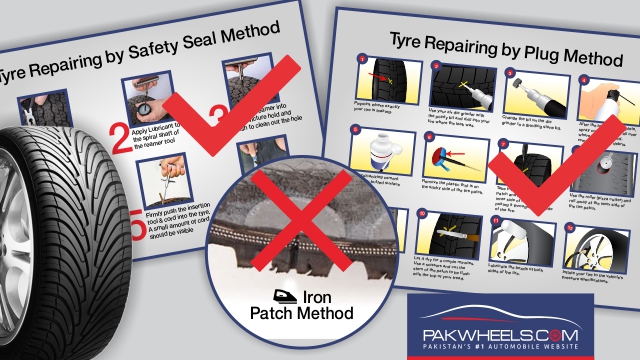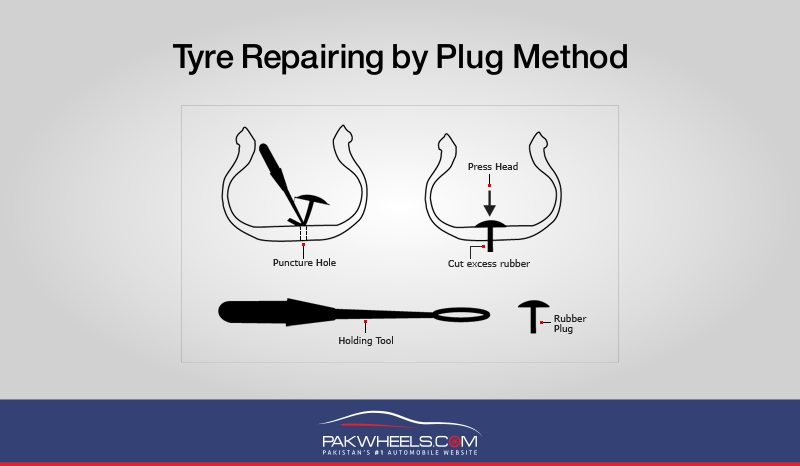PakWheels Infographic: The Correct Way To Fix A Tyre Puncture
Tyres being a vital part of a car need to be kept in the most immaculate conditions possible; well, mainly because they are the only things keeping a car on the road. The ones in Pakistan undergo a lot of stress because of continuous braking, poor road conditions and a hot climate. With all these things in consideration, a tyre is more likely to have a puncture. When repairing a puncture, we try making the tyre as good as new. But which is the best way to do it?
Patch method
Patch method, or commonly known as “Istri(iron) wala puncture,” practices the older way of repairing tubes. This is now also used to repair tubeless tyre punctures. The person first cleans the puncture site and then applies an adhesive. He then sticks a rubber patch on the adhesive. Pressure and heat is applied for a certain time to let the patch sit firmly on to the rubber.
This method is least recommended by tyre manufacturers as it only seals the inner part of the tyre. The outer part still has a cavity which lets water, moisture and dust damages the tyre. It is also most likely to leak under high stress.
Filler method
Filler method, commonly known as “Sui wala puncture”, uses a probe to pierce through the tyre with a repairing compound in such a way that when the probe is pulled out, the repairing compound has sealed the puncture. The extra compound is then cut off with a blade.
Now, it may sound dangerous or bad for the tyre but tyre manufacturers recommend this for puncture repairs. It seals the tyre from the inside and the outside. A disadvantage of this is that stiff ridges of the repairing compound form on the inside of the tyre which prohibits the use of a tube further. If the tyre has to be tubed, then the inner lining has to be buffed thoroughly.
Plug method
Plug method commonly known as nothing because it isn’t used in Pakistan, uses a plug inserted from the inside of the tyre. It has a head that seals the puncture in the best way possible from the inside as well as on the outside. It then uses a sealant to seal an air gaps that may or may not have formed during the process.
This is the best way recommended by tyre manufacturers as it repairs the tyre perfectly with minimum damage. Unfortunately, we don’t have it in Pakistan, as of yet. Anybody who knows someone who practices the plug method to repair punctures, please feel free to leave a comment below. Your help can revolutionize the way punctures are repaired in Pakistan…………..that’s an overstatement of course but I liked that touch.





and tyre has to be re balanced after repairing puncture for smooth ride……….moreover it is dilemma that patch method is expensive in pakistan than filler method.
Hyeee pakistan ka kya bany ga?
Well
….. Tire manufacturers recommend plug method bcz they want you to
change tyres more frequently…. Plug method actually decreases life of a
tyre. Iron method is still best for longer terms.
Anyone who drives daily for 2-3 decades can tell the difference very easily, why iron method is good !!
Very informative. Now I will find a tyre shop that repairs the puncture by the filler method
Brilliant! Quite helpful.
Just talked on the phone with a guy from (TOTAL gas station) Murree motorway as I’m stuck at the airport, flight got delayed for damn 7 hours & my mom had to go as the tyre got puncture. I was quite curious regarding how they do the puncture. So I asked the guy that ‘BHAI istri wala punture lagate ho’ ya rim uttar k ander wala, tyre na kharab ker dena. He’s like nae bhai sare tarha k puncture kerte hein yaha, before comes up with a new Pakistani technology ;P I was like, ok dehaan se repair kerdo.
Perhaps now its common all over Pakistan.
Well that was my feedback on it, perhaps quite a brief per what to do when you’re stuck at the airport for so long ;0
youre right mister… Iron is the best…
i m confused i found filler method always leak after some time.
Filler method always.
In Pakistan people stick to old methods without any logic. I think one should be willing to adapt to recommendations if coming from authetic sources. Why donot you give some argument on why iron method is best? It should be valid argument not just your experience because we already know that now.
Filler method may damage the steel threads meshing within different layers of rubber, reducing strength of tyre and main cause of brust.
Traditional puncture method or patch method may get leaked again but using tubeless tyres will not affect you as bad as getting is brustrd on high speeds
So i totally disagree with filler method, patching at present is the safest way to get your puncture tyre rectified
Saabco tyre sealant Best one first manufacturing of pakistan.seal puncture permanantly upto 6mm diameter in a second.
I myself a Tyre mechanic, having shop at I & T center G-10/4, Islamabad. Through experience I learned filler method is satisfactory method, it saves the alloy rim from scratches and keep the tyre balance. The steel wires in the trye; are very strong item of the tyre, cannot be damaged by the tool we insert in the tyre. For patch punctures I personally takes much care not to scratch the Alloy Rim but very difficult. After patch puncture, putting back the tyre balance is not possible.